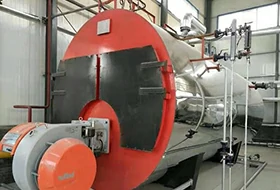
Feb . 06, 2025 05:57 Back to list
Biomass fired steam boiler
Draining a steam boiler may seem daunting to many, especially those who have never handled such a task before. Nevertheless, with the right tools and instructions, it can be carried out safely and effectively. This guide walks you through the comprehensive and safe process of draining your steam boiler while ensuring optimal performance and longevity of your equipment.
6. Flushing the System For a more thorough clean and to dislodge any persistent particles, it might be helpful to flush the boiler system with fresh water. Keep the drain valve open while introducing fresh water through the boiler feed valve, thereby purging any remaining sediments. 7. Inspecting for Issues As the water drains, take the opportunity to inspect the boiler for any signs of wear, corrosion, or damage. Early detection of these issues can prevent costly repairs or replacements in the future. 8. Closing the Valve Once the boiler is thoroughly drained and inspected, securely close the drain valve. Be sure that the hose has been completely removed and stored away properly for its next use. 9. Refilling the Boiler Refill the boiler with fresh water through the feed valve, observing recommended water level parameters. This helps ensure your boiler is ready to deliver optimal performance when started. 10. Final Checks and Power Restoration Before restoring power to your boiler, double-check that all valves are securely closed and that the system is properly refilled with water. Reactivate the power supply, then observe the boiler as it returns to normal function. Listen for any unusual sounds or leaks, and address any concerns immediately. Through attentive maintenance habits, including regular draining of your steam boiler, you can sustain its efficiency and extend its service life. This not only guarantees consistent heat and hot water supply but also contributes to safety and energy savings. Remember, while these steps provide a comprehensive guide, the complexity of boiler systems can vary. It might be wise to consult with a heating engineer or professional if you are uncertain about your equipment or detect any operational anomalies. Reputable manufacturers and service providers not only offer equipment but can often provide authoritative advice and trustworthy service to ensure your system works optimally.


6. Flushing the System For a more thorough clean and to dislodge any persistent particles, it might be helpful to flush the boiler system with fresh water. Keep the drain valve open while introducing fresh water through the boiler feed valve, thereby purging any remaining sediments. 7. Inspecting for Issues As the water drains, take the opportunity to inspect the boiler for any signs of wear, corrosion, or damage. Early detection of these issues can prevent costly repairs or replacements in the future. 8. Closing the Valve Once the boiler is thoroughly drained and inspected, securely close the drain valve. Be sure that the hose has been completely removed and stored away properly for its next use. 9. Refilling the Boiler Refill the boiler with fresh water through the feed valve, observing recommended water level parameters. This helps ensure your boiler is ready to deliver optimal performance when started. 10. Final Checks and Power Restoration Before restoring power to your boiler, double-check that all valves are securely closed and that the system is properly refilled with water. Reactivate the power supply, then observe the boiler as it returns to normal function. Listen for any unusual sounds or leaks, and address any concerns immediately. Through attentive maintenance habits, including regular draining of your steam boiler, you can sustain its efficiency and extend its service life. This not only guarantees consistent heat and hot water supply but also contributes to safety and energy savings. Remember, while these steps provide a comprehensive guide, the complexity of boiler systems can vary. It might be wise to consult with a heating engineer or professional if you are uncertain about your equipment or detect any operational anomalies. Reputable manufacturers and service providers not only offer equipment but can often provide authoritative advice and trustworthy service to ensure your system works optimally.
Share
Latest News
-
High-Efficiency Commercial Oil Fired Steam Boiler for Industry
NewsJul.30,2025
-
High-Efficiency Biomass Fired Thermal Oil Boiler Solutions
NewsJul.30,2025
-
High Efficiency Gas Fired Thermal Oil Boiler for Industrial Heating
NewsJul.29,2025
-
High-Efficiency Gas Fired Hot Water Boiler for Sale – Reliable & Affordable
NewsJul.29,2025
-
High Efficiency Biomass Fired Hot Water Boiler for Industrial and Commercial Use
NewsJul.29,2025
-
High-Efficiency Biomass Fired Hot Water Boiler for Industrial Use
NewsJul.28,2025
Related PRODUCTS
Copyright © 2025 HEBEI HONGZE BOILER MANUFACTURING CO., LTD. All Rights Reserved. Sitemap | Privacy Policy






















